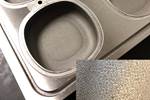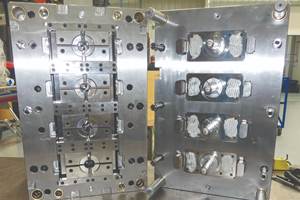How to Overcome Complex Mold Texturing Problems
Key benefits when considering laser technology for mold texturing and repair.

Mold builders can laser texture directly over an EDM mold cavity with no required polishing. Photo Credit: St. Paul Engraving
The mold manufacturing industry is constantly evolving. As a result, options for overcoming complex mold texturing challenges are evolving, too.
Our complex marketplace demands new and innovative design possibilities with higher accuracy and tighter tolerances while keeping production times as short as possible. For example, some projects may require depth or detail unachievable by acid etching, while others demand consistent results with high-volume multi-cavity tools.
Laser texturing might be the right solution to overcome these complex challenges. Here are a few key advantages to consider.
Laser Texturing Benefits
Laser texturing is a fully digital process that replicates all industry-standard patterns and allows for virtually limitless design possibilities. Laser texturing does not undercut detail, which is problematic with acid etching that moves outward as it etches downward. The key to laser texturing is the 0.002-inch beam width that unlocks the potential to achieve depths and details not possible through acid etching, and permits the design of innovative, complex patterns to meet the rapidly changing needs of the medical, aerospace, automotive, defense and consumer goods industries.
A good rule of thumb is: If the EDM finish is lighter than the texture you are applying, you can laser texture over the EDM finish.
As a fully digital process, laser texturing delivers highly repeatable precision results, which is not only ideal for maintaining consistency throughout projects but allows the operator the ability to pick back up on molds for repair or to refurbish the texture on high-volume tools that may wear over time.
Also, in most cases, you do not need to remove the EDM layer to laser texture a mold. Avoiding this step reduces the time and cost associated with polishing, which also helps to maintain tight tolerances. However, the surface finish requirements of the texture dictate the need for polishing.
A good rule of thumb is: If the EDM finish is lighter than the texture you are applying, you can laser texture over the EDM finish.
When machining a mold, mistakes and cutter breakage can occur, resulting in weld that is often undetectable until you apply a texture. Chemical etching can bring out weld areas and yield an uneven texture.
Laser texturing, on the other hand, is not as susceptible to weld and hardness issues. In most cases, it is completely unaffected. Laser texturing produces consistent results regardless of the mold’s condition.
Laser Repair Benefits
Taking a mold out of production for a texture repair or revision is never ideal because lead time is critical. However, laser repair is not only the fastest solution, but offers the greatest results. The process offers several key advantages when you damage a mold texture that was either laser textured or chemically etched.
When welding is necessary there are several variables to consider, including steel type and size of the weld area. Be aware of hardness issues that may arise when welding. For example, a block that draws heat away from the weld too quickly produces an uneven hardness and allows acid etching to reveal rings. Tempering the block can fix this issue, but it is a time-consuming process that does not guarantee success.
When laser repairing, you can texture over the weld and blend into the existing texture—whether initially chemically etched or laser textured—without any issues.
Using laser technology for your next texture project or repair will avoid costly delays due to EDM or weld.
Related Content
Surface Finish: Understanding Mold Surface Lingo
The correlation between the units of measure used to define mold surfaces is a commonly raised question. This article will lay these units of measure side by side in a conversion format so that companies can confidently understand with what they are dealing.
Read MorePrecision Welding Services Offer Rapid Turnaround Mold Repair and Reduced Molder Downtime
X-Cell Tool & Mold relies on outsourced, high-quality welding repairs from Lewis-Bawol Welding to ensure its customers' molds are back in production quickly and affordably.
Read MoreBreaking Down 3D Scanning in Moldmaking
Identifying 3D scanning requirements and implementing the appropriate technology.
Read MoreRead Next
The Impact of Laser Technology Advancements on Moldmaking
A look at how improved laser technology benefits mold texturing, engraving and micromachining.
Read MorePrecision Laser Technology Utilizes Laser Texturing for Plastic Injection Molds
PLT is to demonstrate its advanced, five-axis laser technology to Amerimold attendees, showcasing its extended texturing capabilities, design versatility and more.
Read MoreA Look at Mold Texturing
Laser texturing, if understood and appreciated, can open up the door to endless possibilities in texturing, according to this texture house.
Read More

























